How Wastewater Treatment Plants Work
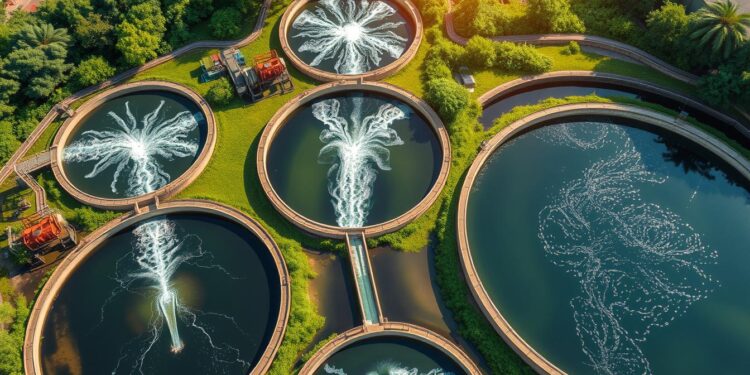
Wastewater treatment plants are key to keeping our water clean and safe. They remove harmful stuff from water used by homes, businesses, and industries. This way, water can be safely returned to nature.
The process of cleaning water is quite complex. It can get rid of up to 99% of bad stuff in water. Modern plants use advanced tech to make dirty water clean and usable again.
At the heart of it, these plants use a multi-step method to get rid of dangerous stuff. The EPA calls this one of the best ways to fight pollution in the U.S. Every day, they handle about 34 billion gallons of wastewater.
Table of Contents
- 1 Introduction to Wastewater Treatment Systems
- 2 Understanding the Wastewater Collection Process
- 3 How Wastewater Treatment Plants Work
- 4 Primary Treatment: The First Stage of Purification
- 5 Screening and Grit Removal Processes
- 6 Secondary Treatment and Biological Processes
- 7 The Activated Sludge Process
- 8 Tertiary Treatment and Advanced Purification
- 9 Disinfection Methods in Water Treatment
- 10 Sludge Processing and Management
- 11 Environmental Impact and Regulations
- 12 Modern Technologies in Wastewater Treatment
- 13 Effluent Discharge and Water Reuse
- 14 Conclusion
Key Takeaways
- Wastewater treatment removes up to 99% of harmful materials
- The process involves three primary treatment stages
- Treatment plants protect public health and ecosystems
- Advanced technologies ensure water safety
- 34 billion gallons of wastewater are processed daily in the U.S.
Introduction to Wastewater Treatment Systems
Water treatment has changed a lot from ancient times. The history of sewage treatment shows how we’ve learned about keeping water clean and protecting the environment.
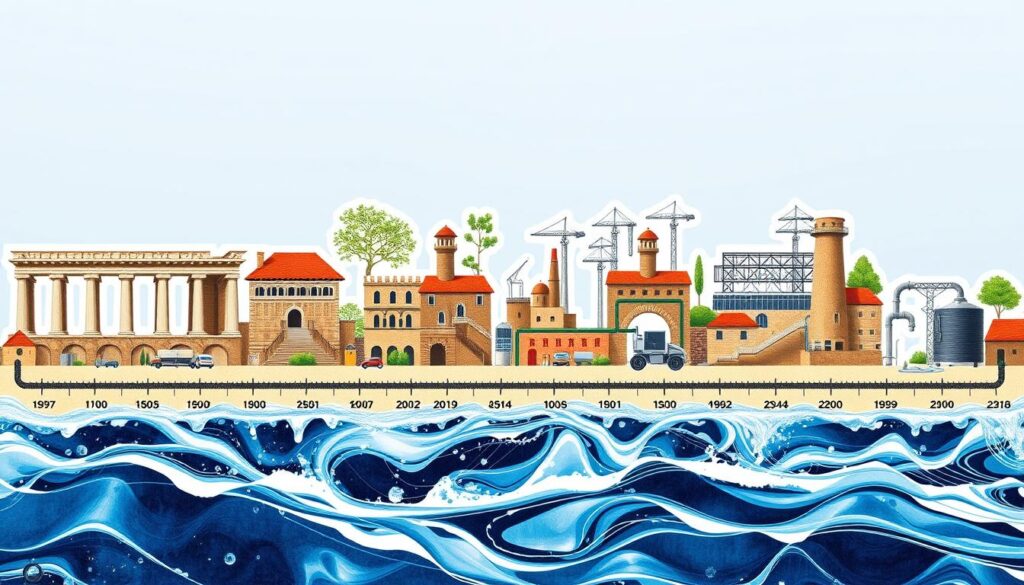
The history of water treatment goes back thousands of years. The ancient Romans built systems like the Cloaca Maxima, which is over 2,500 years old.
“Dilution is the solution to pollution” was once the prevailing philosophy
– a concept that has been proven wrong.
The Evolution of Water Treatment
Water purification has seen big changes over time. Important moments include:
- 19th-century public health crises triggered by cholera outbreaks
- Late 19th-century construction of centralized sewage treatment plants
- Mid-20th-century environmental regulations
- Advanced technological innovations in sewage treatment
The Importance of Modern Treatment Facilities
Today’s wastewater treatment plants are key for public health and the environment. The world of sewage treatment shows big differences:
- 52% of global sewage is treated
- High-income countries treat 74% of sewage
- Developing countries treat only 4.2% of sewage
Basic Functions and Objectives
Modern sewage treatment systems aim to remove harmful substances. They prepare water for safe release into the environment or for reuse. The process involves several stages to clean the water through mechanical, biological, and chemical methods.
Water purification is a big challenge worldwide. Technologies are always improving to meet environmental and population needs. The United Nations sees wastewater as a vital resource for solving freshwater issues in our complex world.
Understanding the Wastewater Collection Process
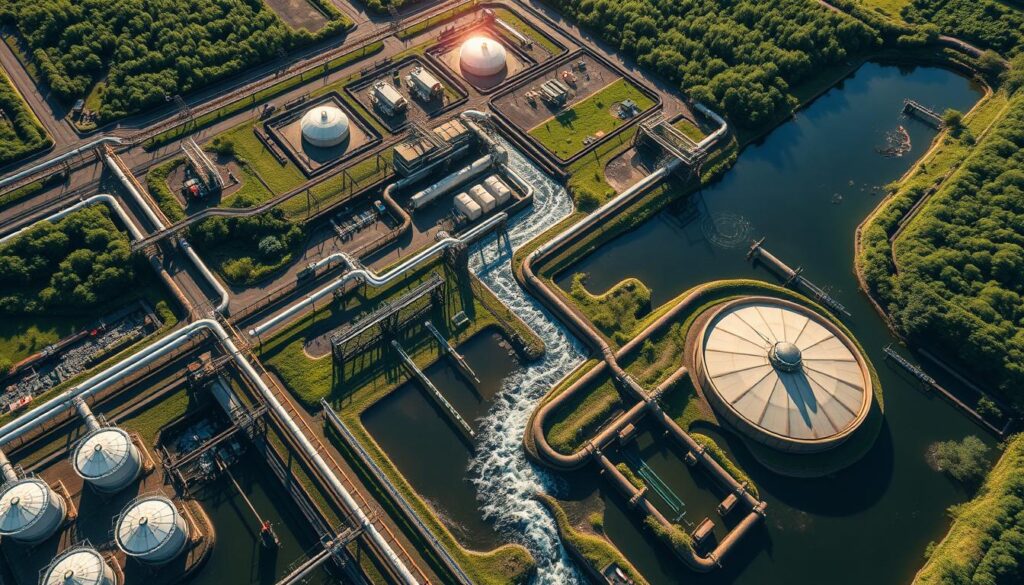
The wastewater treatment process starts with a network of collection systems. These systems gather dirty water from homes, businesses, and factories. They form a key part of managing water in our communities.
Wastewater collection has several important parts:
- Extensive underground pipe networks
- Pumping stations in communities
- Catchment areas for water flow
There are different types of wastewater in the system:
- Domestic wastewater from homes and apartments
- Industrial wastewater from factories
- Stormwater runoff from cities and countryside
“Every drop of wastewater tells a story of urban infrastructure and environmental management.”
The design of these systems depends on many factors. These include how many people live in an area, the land’s shape, and local water systems. For example, New York City has 14 facilities for treating wastewater, showing how complex water management can be.
It takes about 8-10 hours to clean wastewater. The first step in collecting it is key to making sure the water is clean later on.
How Wastewater Treatment Plants Work
Wastewater treatment plants are key in making water safe again. They turn dirty water into clean, usable water. These plants handle about 450 million litres of water every day. That’s like filling 180 Olympic-sized swimming pools.
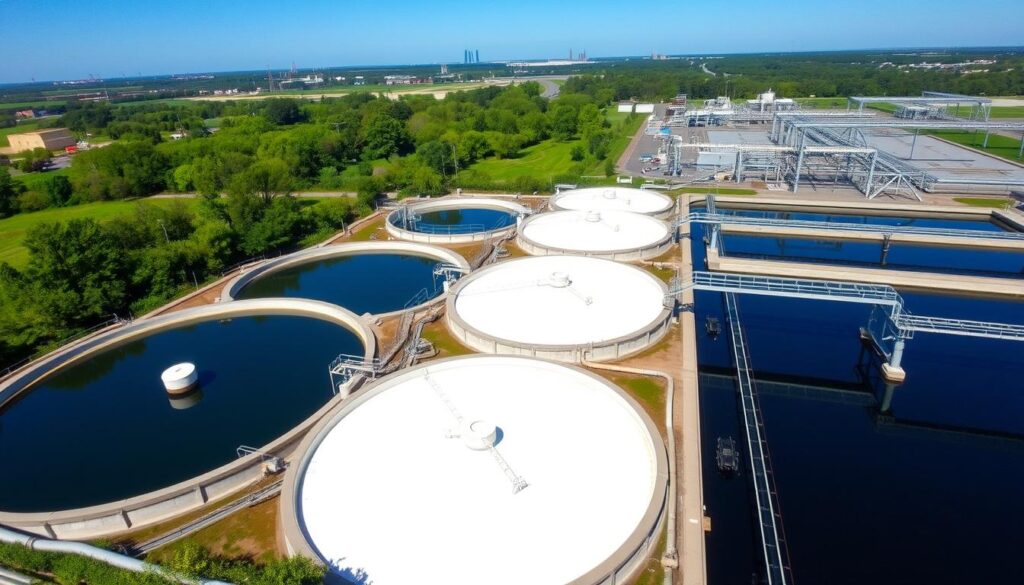
The process of cleaning water is complex. It involves removing harmful substances to keep our environment safe. To understand this, we need to look at the treatment cycle and the important parts of the plant.
The Complete Treatment Cycle
Water goes through three main steps:
- Preliminary Treatment
- Primary Treatment
- Secondary Treatment
- Tertiary Treatment
System Components and Their Functions
Each plant has key parts to clean the water:
- Screening Equipment
- Grit Removal Chambers
- Settling Tanks
- Biological Reactors
- Disinfection Systems
“Water treatment is not just a process, but a critical environmental protection strategy.”
Treatment Plant Infrastructure
The plant’s setup includes:
| Infrastructure Component | Primary Function |
|---|---|
| Pumps | Water movement and pressure regulation |
| Pipes | Water transportation between treatment stages |
| Control Systems | Monitoring and managing treatment processes |
| Monitoring Equipment | Tracking water quality and treatment efficiency |
Modern wastewater treatment plants are engineering marvels that protect public health and environmental sustainability.
Primary Treatment: The First Stage of Purification
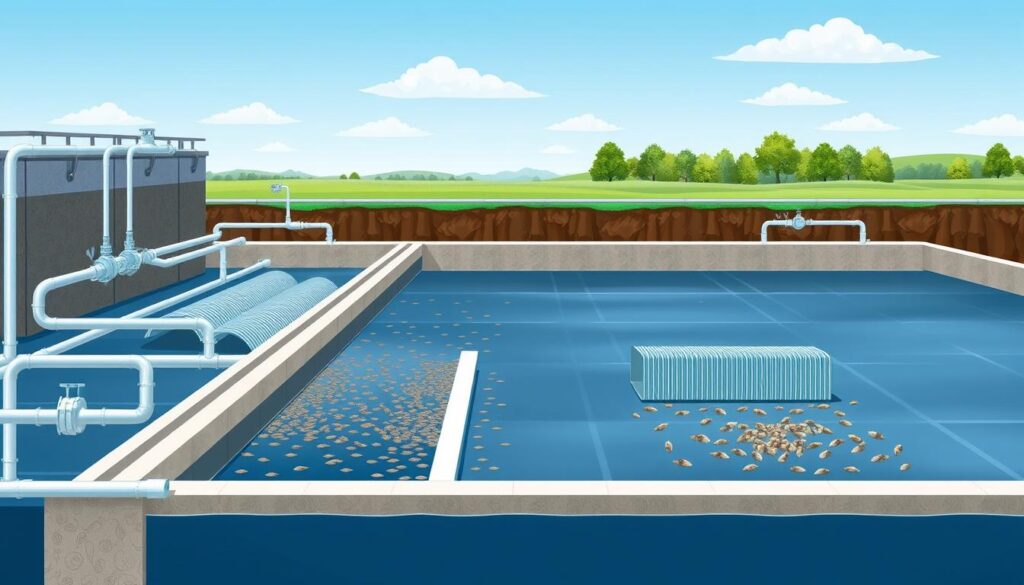
The wastewater treatment process starts with primary treatment. This stage is key for removing big contaminants. It gets sewage ready for further cleaning.
In this phase, about 60% of suspended solids are taken out. This makes a good base for more advanced cleaning steps.
“Primary treatment is the gateway to transforming contaminated water into a cleaner, safer resource.”
Primary treatment includes several important steps:
- Screening to remove large debris
- Grit removal using specialized chambers
- Sedimentation tanks for particle separation
The sedimentation process is very important. Tanks give solids two hours to settle. Heavier particles sink to the bottom, and lighter ones rise to the top.
| Primary Treatment Stage | Removal Efficiency |
|---|---|
| Suspended Solids Removal | 60% |
| Processing Time in Sedimentation Tanks | 2 hours |
| Purpose | Protect downstream equipment and prepare for secondary treatment |
Big industries like pharmaceutical, paper, textile, and petroleum need good primary treatment. It removes physical contaminants and protects equipment in later steps.
Primary treatment separates solids by density. This creates sewage sludge. It can be used through anaerobic digestion or as liming material. This shows how efficient and sustainable modern wastewater treatment is.
Screening and Grit Removal Processes
The wastewater treatment process starts with important steps. These steps protect equipment and make sure water is clean. Screening and grit removal are key to handling wastewater well.
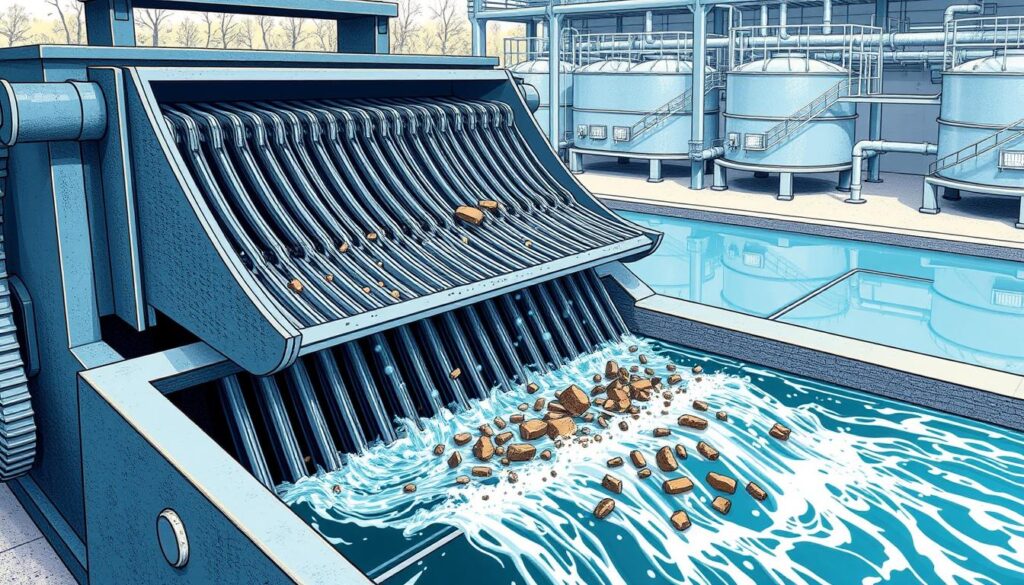
Screening is vital for removing big debris. It keeps treatment systems running smoothly. Wastewater plants use different screening methods for this.
Types of Screening Equipment
There are various screening methods for water purification:
- Coarse screens (6mm openings) remove large solids and debris
- Fine screens (1.5-6mm openings) target smaller problematic materials
- Very fine screens (0.2mm openings) reduce suspended solids effectively
Grit Chamber Operations
Grit chambers are important for separating heavy particles from wastewater. They help protect equipment from damage.
| Grit Removal System | Characteristics | Efficiency |
|---|---|---|
| Aerated Grit Chambers | Uses air circulation | High separation rate |
| Vortex Systems | Circular flow design | Moderate efficiency |
| Hydrocyclones | Centrifugal separation | Precise particle removal |
Initial Sedimentation Process
The first sedimentation stage helps solids settle. This makes the next steps in water purification better. Horizontal flow grit chambers keep a steady flow, helping separate particles well.
“Proper screening and grit removal are essential for maintaining treatment plant efficiency and protecting critical infrastructure.”
Using advanced screening and grit removal, treatment plants can make water cleaner. This also makes the systems more reliable.
Secondary Treatment and Biological Processes
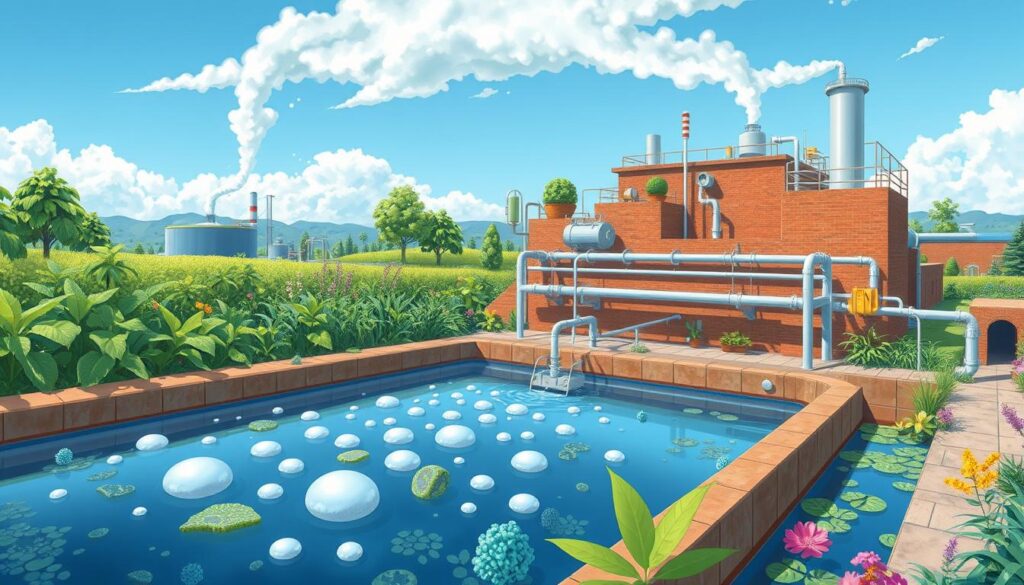
Secondary treatment is a key part of the wastewater process. It focuses on removing dissolved organic matter using biological methods. This stage can get rid of up to 90% of suspended solids, thanks to microorganisms.
The biological treatment changes organic contaminants into useful products. These include:
- Water
- Carbon dioxide
- More microorganisms
In the activated sludge process, plants use aeration and flocculation. These methods create a perfect environment for bacterial communities to grow. They efficiently break down pollutants.
Microorganisms are nature’s ultimate purification agents, converting complex organic compounds into simpler, harmless substances.
There are different biological treatment methods, each with its own features:
- Trickling filters
- Activated sludge systems
- Moving bed biofilm reactors
The activated sludge process is very effective. It forms a sludge blanket of biosolids called flocs. These flocs are key in capturing and processing organic pollutants.
Treatment plants control oxygen levels and bacterial populations. This ensures pollutants are removed efficiently. The water quality meets strict environmental standards.
The Activated Sludge Process
Wastewater treatment uses biological processes to clean water. The activated sludge process is key, using tiny organisms to break down waste. This makes water cleaner.
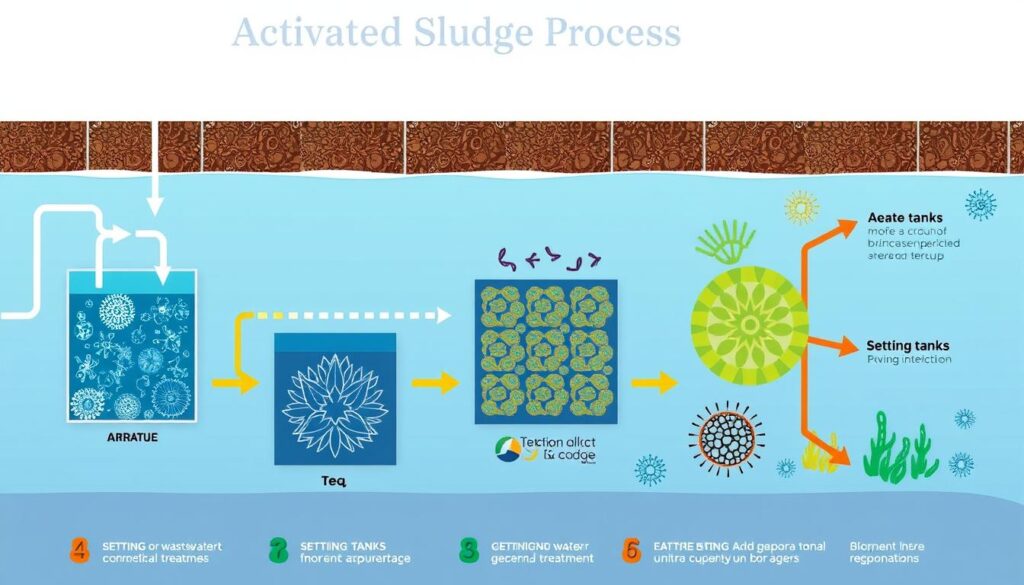
Aeration Tank Operations
Aeration tanks are vital in the activated sludge process. They add oxygen for bacteria to grow. The main tasks are:
- Mixing sewage with air and bacterial sludge
- Keeping the right amount of dissolved oxygen
- Helping microbes remove contaminants
Bacterial Action in Treatment
Microorganisms are the heart of the activated sludge process. They eat organic matter, turning it into safe substances. Their success depends on:
- Enough dissolved oxygen
- The right temperature
- Having the right nutrients
Sludge Recycling Methods
Sludge recycling boosts treatment efficiency. It involves adding some settled biomass back to the aeration tanks. This keeps a high level of active microbes.
The activated sludge process effectively reduces organic matter by up to 90% through biological treatment.
| Process Parameter | Typical Value | Impact |
|---|---|---|
| Dissolved Oxygen | 2 mg/L | Ensures bacterial settlement |
| Sludge Volume Index | 30-minute settling | Measures sludge compaction |
| Waste Activated Sludge | 80 g/m³ | Standard production rate |
Treatment plants watch these factors closely. They adjust them to keep the activated sludge process running well. This ensures water is purified efficiently.
Tertiary Treatment and Advanced Purification
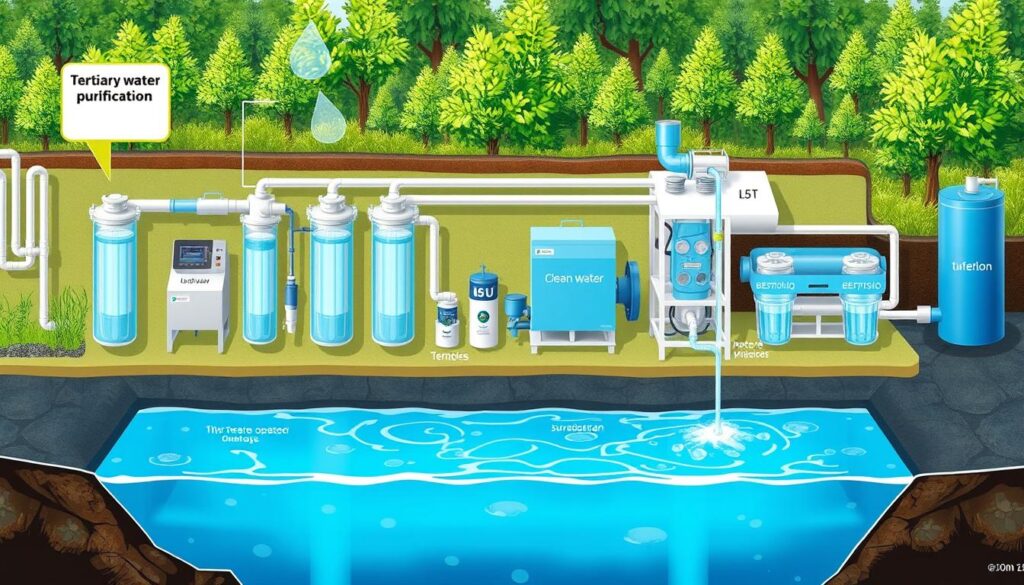
Tertiary treatment is the last and most advanced stage of water purification. It goes beyond the usual steps to remove tiny pollutants. This ensures water is very clean for different uses.
The main aim of tertiary treatment is to make water so clean it can safely go back into nature or be reused. It uses many advanced methods to get rid of pollutants that earlier steps can’t handle.
- Removes up to 99% of remaining impurities
- Targets specific contaminants like nitrogen and phosphorus
- Prepares water for possible reuse in industrial and agricultural settings
Advanced purification in tertiary treatment includes several key steps:
- Filtration using sand or membrane technologies
- Chemical treatment with special compounds
- Biological nutrient removal
- Disinfection through chlorination or UV light
| Treatment Method | Effectiveness | Primary Application |
|---|---|---|
| Membrane Filtration | 95-99% Contaminant Removal | Industrial Water Reuse |
| Biological Nutrient Removal | 80-90% Nitrogen/Phosphorus Reduction | Environmental Protection |
| Chlorination | 99.9% Bacterial Elimination | Drinking Water Safety |
“Tertiary treatment transforms wastewater from a possible environmental danger into a valuable resource.” – Water Treatment Expert
Using tertiary treatment is key to protecting our water bodies and meeting strict environmental rules. Advanced purification methods help treatment plants lessen the harm of wastewater discharge.
Disinfection Methods in Water Treatment
Water purification is key for public health and the environment. Disinfection is the last step to remove harmful germs from wastewater before it goes back into nature.
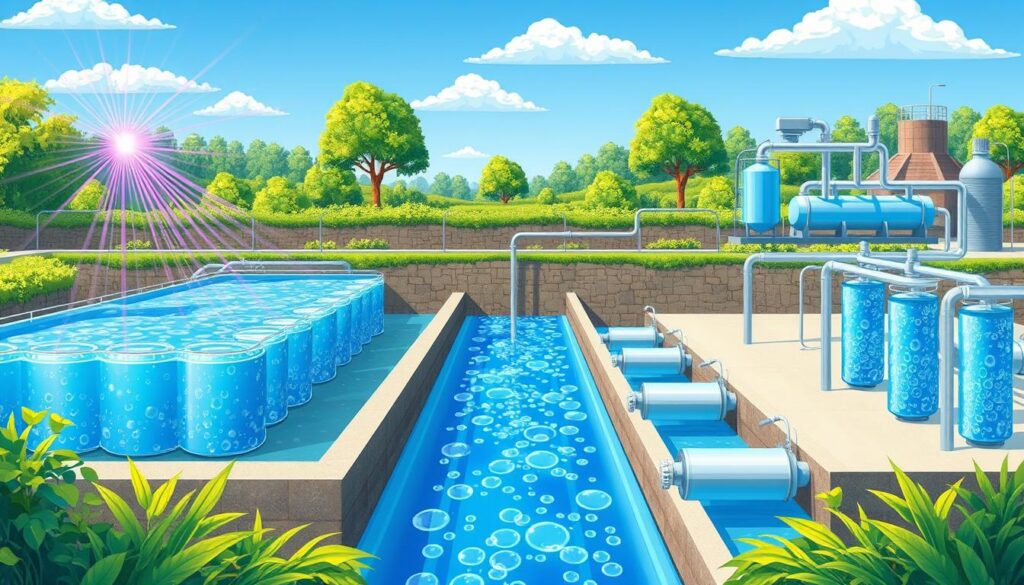
Wastewater treatment plants use different ways to kill harmful germs. The main methods are chlorination, ultraviolet light, and ozone.
Chlorination Techniques
Chlorination is the most common method in the U.S. It adds chlorine to kill bacteria and prevent water-borne diseases.
- Effective against many pathogens
- Keeps water safe in pipes
- Is relatively cheap
UV Light Treatment
Ultraviolet light is another way to kill germs. It works by breaking their DNA.
- Does not use chemicals
- Does not change taste or smell
- Is good for the environment
Ozone Applications
Ozone is a strong method for purifying water. It has powerful disinfecting abilities.
| Disinfection Method | Effectiveness | Environmental Impact |
|---|---|---|
| Chlorination | High | Potential chemical by-products |
| UV Light | Moderate | Minimal environmental risk |
| Ozone | Very High | Low residual impact |
The EPA suggests using germs like Enterococci and E. coli to check if disinfection works. Each method has its own benefits. Treatment plants choose based on water quality, germ levels, and rules.
Effective disinfection is key to keeping people safe and stopping waterborne diseases.
Sludge Processing and Management
Managing sludge is key in wastewater treatment. About 99% of wastewater is treated and released again. The rest needs special handling and disposal.
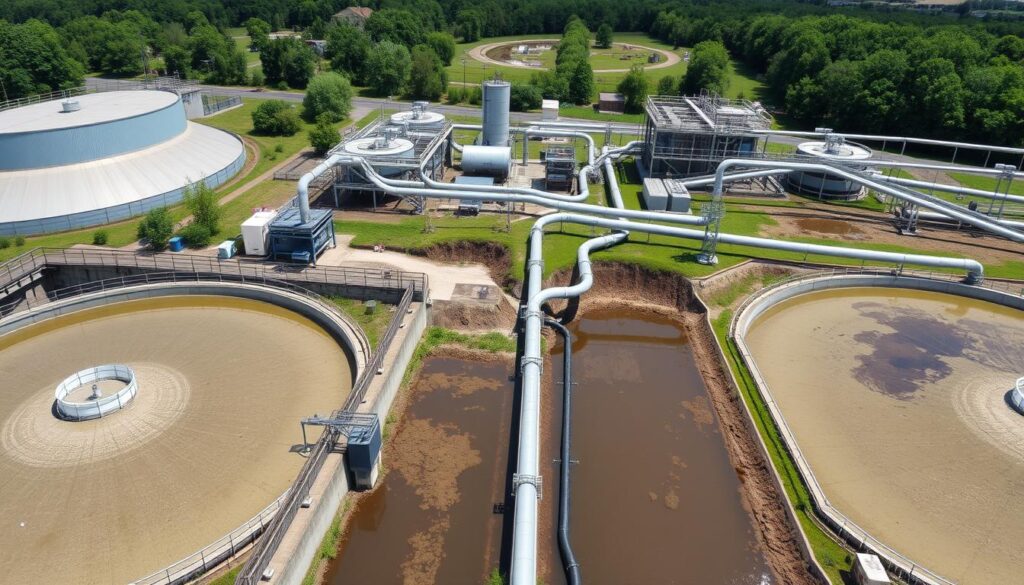
Raw sewage sludge has 1 to 4% solids after treatment. In the U.S., Publicly Owned Treatment Works (POTWs) produce about 0.16 pounds of sludge daily for each person.
Sludge Processing Methods
- Thickening: Concentrating sludge volume
- Digestion: Reducing organic content
- Dewatering: Removing excess water
- Stabilization: Controlling biological activity
The sludge digestion process has two phases:
- First Phase: Acid-forming bacteria break down large molecules
- Second Phase: Bacteria turn molecules into carbon dioxide and methane
“Sludge management transforms waste into a valuable resource through smart processing.”
Anaerobic digestion reduces solid mass and kills harmful pathogens. Modern dewatering, like centrifugation, is more efficient than old methods.
Disposal and Beneficial Use Options
- Land application as agricultural fertilizer
- Energy recovery through anaerobic digestion
- Incineration for ash conversion
- Controlled landfill disposal
Sludge treatment’s success depends on its chemical makeup. This makeup affects the chance to get valuable products from the sewage treatment process.
Environmental Impact and Regulations
Wastewater treatment is key to protecting our environment. It tackles complex ecological challenges. The systems for effluent discharge need strict oversight to avoid environmental harm.
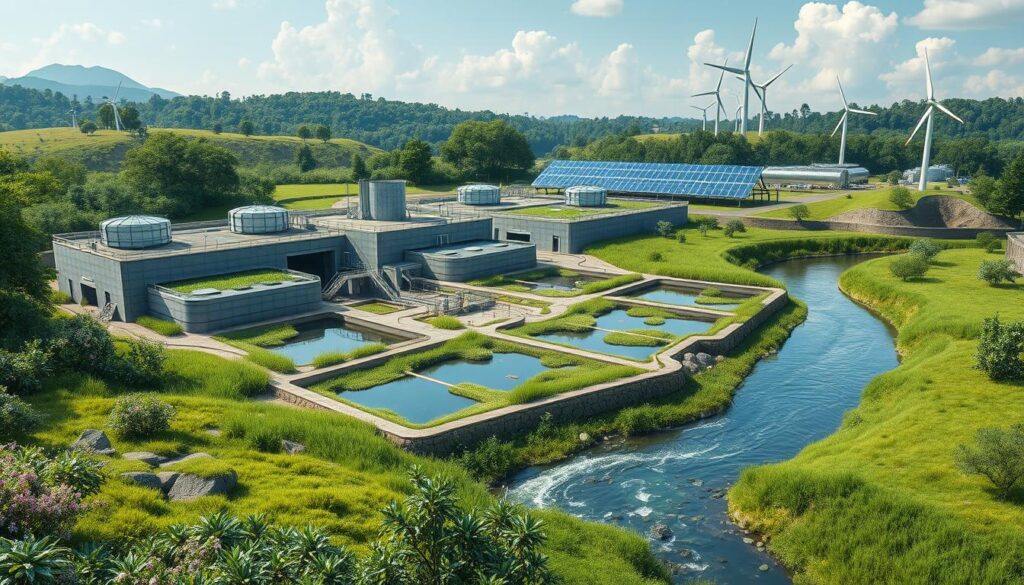
Wastewater treatment plants face big environmental challenges. They need strong management strategies to handle these issues:
- Energy use from non-renewable sources
- Greenhouse gas emissions
- Sludge generation with pathogen risks
- Nutrient management to avoid ecosystem harm
EPA Standards and Compliance
The Environmental Protection Agency (EPA) sets strict rules for wastewater treatment. These rules aim to:
- Reduce toxic metal levels
- Control nutrient discharge
- Stop eutrophication in water bodies
“Continuous monitoring ensures the protection of public health and environmental sustainability.”
Environmental Protection Measures
Treatment facilities use new technologies to lessen environmental harm:
- Biological Nutrient Removal (BNR) processes
- Membrane filtration
- Life Cycle Assessment (LCA) for better processes
- New sludge management methods
About 66% of greenhouse gases from water and sewage companies come from wastewater treatment. This shows the urgent need for green practices and better technology in managing effluent discharge.
Modern Technologies in Wastewater Treatment
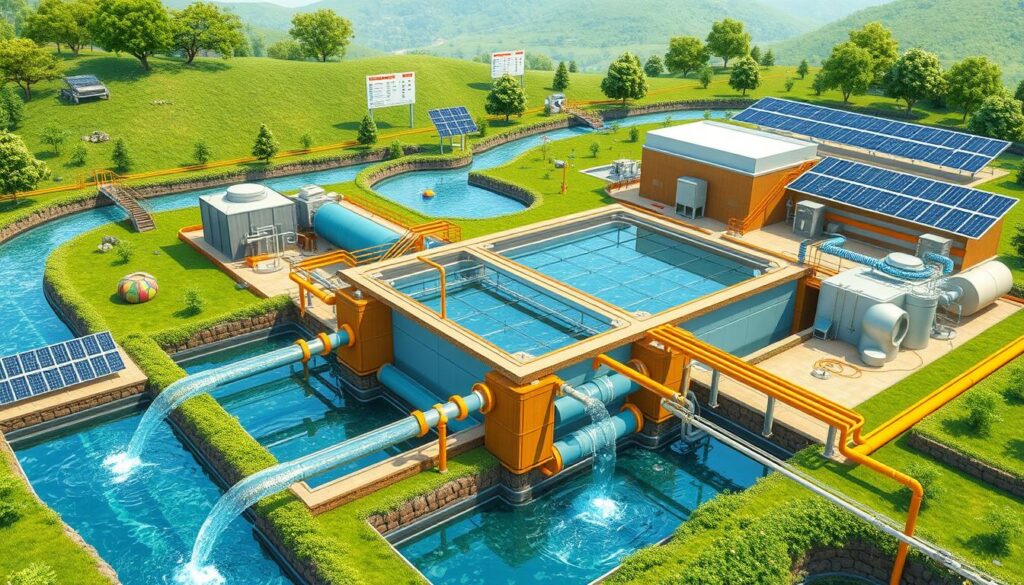
The way we treat wastewater is changing fast. New technologies are making water purification systems better at tackling tough environmental problems. Today’s treatment plants use advanced tech to handle complex pollutants.
Some big advancements in water treatment include:
- Digital twin technology for predictive monitoring
- Machine learning algorithms for process optimization
- Advanced membrane filtration systems
- Nanotechnology-based purification methods
Automation is key in modern wastewater treatment. Real-time process monitoring can boost productivity by up to 30%. IoT devices help track sewer networks, cutting down illegal discharges by 20%.
“Technology is revolutionizing how we approach water treatment, making processes more efficient and environmentally friendly.” – Environmental Engineering Research Institute
New technologies tackle tough pollutants in creative ways:
- Photocatalytic oxidation can break down organic contaminants by over 80%
- Electrocoagulation removes up to 95% of suspended pollutants
- Advanced oxidation processes can destroy over 90% of persistent organic compounds
Sustainability is a big focus in modern wastewater treatment. Renewable energy, like solar panels, can power 20-30% of treatment plants. Companies are working on new tech that treats water and also finds valuable resources.
The future of wastewater treatment is about smart, connected systems. These will use advanced filters, data analysis, and green practices to protect our water.
Effluent Discharge and Water Reuse
Effluent discharge is a key part of water purification. It’s when treated wastewater is safely put back into the environment. Modern treatment plants work hard to make sure the water is clean enough for the environment.
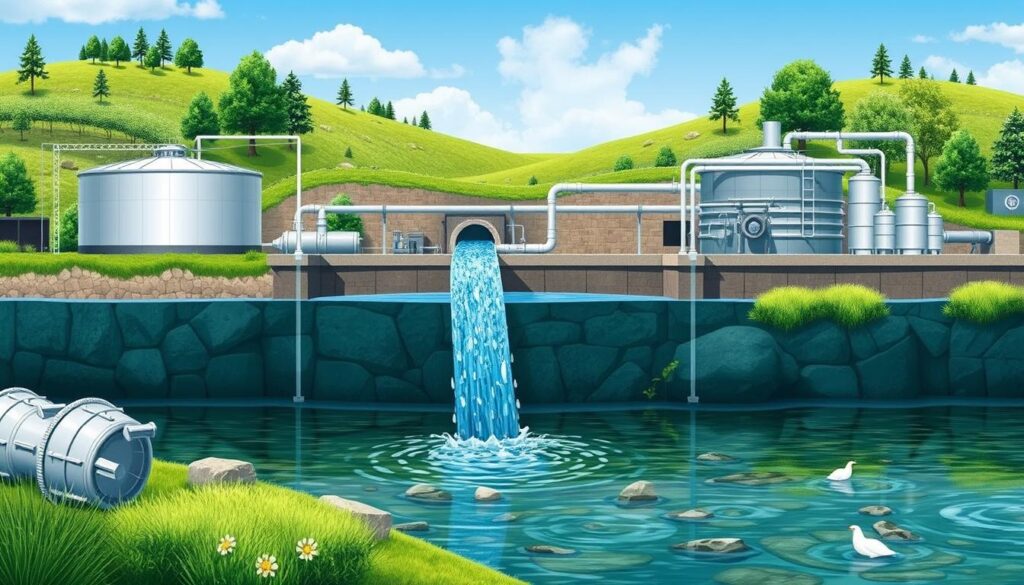
Water reuse is a smart way to deal with water scarcity. It’s used in many ways, like:
- Agricultural irrigation
- Industrial processes
- Landscape maintenance
- Groundwater recharge
“Effective water reuse can reduce municipal freshwater demand by 30-50%.” – U.S. EPA Guidelines
Looking at water reuse worldwide shows interesting facts:
| Region | Wastewater Reuse Rate | Key Characteristic |
|---|---|---|
| Israel | 90% | Agricultural irrigation |
| China | 41% | Rapid infrastructure development |
| United States | 10-29% | Strict regulatory compliance |
Water purification is very important. It makes sure effluent discharge is safe for the environment. Cities spend a lot on new technologies to clean water well and use it wisely.
New technologies are helping water reuse get better. They help remove bad stuff and keep people safe. The future of water management will depend on how well we can turn wastewater into something useful.
Conclusion
How wastewater treatment plants work is a key part of keeping our environment clean. These plants play a big role in saving water and keeping us healthy. They turn bad water into something we can use again.
The process starts with four main steps: preliminary, primary, secondary, and sludge treatment. In the primary stage, waste goes down by 60%. Then, microbes in the secondary stage remove harmful stuff from the water. Advanced methods like membrane bioreactors help make the water even cleaner.
Today’s wastewater treatment systems save a lot of water, up to 40%. Cities are learning how important these plants are for saving water. New methods like biofiltration make recycling water cheaper and more effective.
As water becomes scarcer, these plants will be more important than ever. They turn waste into something useful, helping us solve big environmental problems. These plants are essential for a sustainable future.






